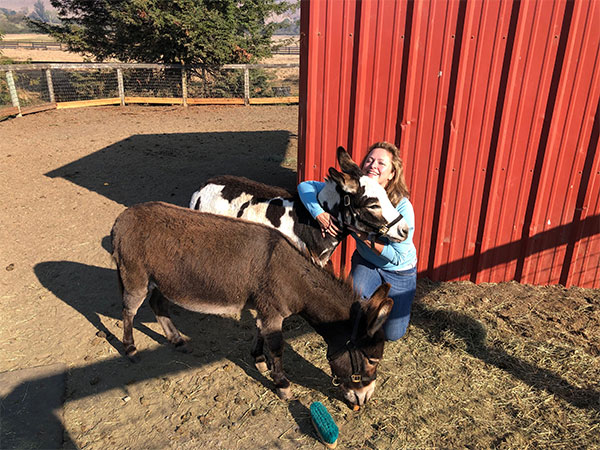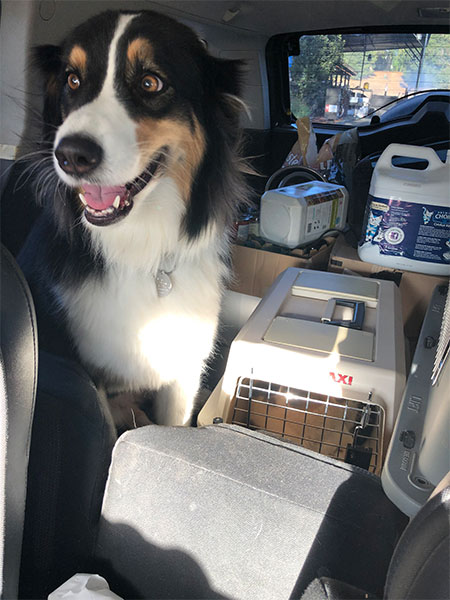As part of our coverage of the Kincade fires, our editors are interviewing residents impacted in Sonoma.
Karen Daenen and William Allen of Two Shepherds tend an apple orchard and a pasture full of donkeys, goats and chickens; they grow vegetables and two acres of grenache—one noir and one gris—in Fulton. They crushed grapes from those vines for the first time this harvest at their winery in Windsor. Three years ago, they moved out of their farmhouse into an RV for eight months, modeling their restoration after a home in the French countryside. Allen was on a flight to New York to attend the RAW Wine event in Brooklyn when the Kincade fire broke out.


What was happening before you left for New York? Were there warnings yet?
Karen Daenen: The fire hadn’t started yet. William left on Tuesday, and I was going to join him on Friday. We had a house sitter coming Wednesday night.
William Allen: I have to look at my Instagram feed for reference, because it happened so fast. I posted [on Thursday]: ‘No sooner do I land in New York, then a fire breaks out.’ So the fire had started, but back then, it was only 5,000 acres.
We sent the house sitter home. Although, we never expected it to come to what it did. It seemed that [the fire] was at a good level of containment. Then flash forward to Saturday where, all of a sudden, they give 50,000 people evacuation notice.
Karen woke up that morning, and we had heard from our friends in Cloverdale who were much closer to the fire and had animals. They were worried, so they were going to move their animals to our farm.
KD: The ironic thing is we’re actually more in the line of fire than they are, but that’s the way this fire is. They used our trailer to drop off their animals at the Santa Rosa Fairgrounds. Then some friends rallied and helped us find a place to drop off our donkeys and goats in Petaluma. There was no way I could have done all of that on my own.
WA: As the day went on, every plan we made changed. I got to Karen’s parents’ house in Mount Vernon, New York, and things started blowing up. They started evacuating Windsor and Healdsburg, and we were on standby evacuation.


KD: We got the mandatory evacuation notice on my way home from dropping off the donkeys and goats [in Petaluma]. So I was able to pick up our dogs and our cat, water the house, and everything.
What did you do once William got back?
WA: Karen had already taken care of the big stuff. I was somewhat useless on the plane. But we had talked about this and prepared for this. We already have a generator [and water tank] on the farm. She went south to our friend Randy’s house and stayed there with him. His wife Erin was also in New York for Raw Wine and still is. I joined Karen, who was quite exhausted, and Randy at about eleven pm on Saturday night.
What were you seeing visually as all this was happening?
KD: We live close to the Santa Rosa Airport. There’s great comfort in seeing those big planes take off, because they do so much by dropping that pink stuff over the fire. Because we did experience this just two years ago, it’s still really raw, and it can feel like you’re still in the moment. You remember the planes. You remember the smells and what it looks like with all the smoke, and how it hurts your throat when you swallow. And that’s all tough, because you remember what it means.
What’s different this time is that the community is way more prepared. What it makes me want to do is learn more about our terrain and how fire works. I think it’s important for our community to realize, this is how life is now.


At five am, we just got in the car and started to head south. The highways were beyond clogged. It took us an hour to get to Rohnert Park, which is 10 miles away. Just going south, trying to find a place to go to the bathroom, grab a coffee, let the dogs out. I mean, nothing was open, everything was snarled. I got on the phone with a dog-friendly hotel [in San Francisco] where we are right now and grabbed the last room available.
The amazing part is that people were fleeing for their lives, and nobody was shoving each other off the roads. There was one accident the entire morning. People are continuing to rally together. I’m doing so many [Instagram] posts, because so many people have reached out asking, ‘How are you? Are you okay?’
Since you’re not home right now, how are you hearing updates about what’s going on?
WA: We still get all the Nixle text alerts, we still get the Cal Fire alerts. Then there’s Facebook alerts. Everything you can think of. So we are monitoring all of those. I have a dog cam in the house that is turned on, because we have power. It’s a constant stream of remote monitoring and communication and phone calls and texts to an entire network of people to see what’s going on.
How close are the fires to where your home and winery are?
WA: We’ve learned to understand what the maps mean as far as color, coding and size. But the several dozens of fires may have already changed or diminished since the time they were put on the map. There’s some amazing footage we found from the Press Democrat. Dozens of fire trucks in Downtown Windsor, fighting [the fire] house-to-house. They managed to extinguish almost everything. If any of those fires jumped [Highway] 101, the winery is gone.
It’s concerning given we just did a lot of growth and expansion. We have a new truck sitting at the farm, and a new press and new tanks [at the winery]. Plus, we have forty percent more wine in volume this year sitting in barrel. There’s no insurance coverage for a lot of these things. And there’s our farmhouse that we rebuilt three years ago.
Our plan right now is to go back to the farm on Tuesday, as long as we have power, because we need power to have water to defend against spot fires. The risk is, as we saw two years ago, burning pieces of newspaper falling from the sky and little things of ash that carry miles in the wind and deposit.
KD: There’s going to be a lot of changes. We know how important tourism is to Sonoma County. In the past, October has been the time to visit because of harvest. But I think there’s going to be a lot of consideration in changing that. Maybe having people focus on coming in January when it can be beautiful, or other times, because this October season is going to be tough to convince people to return.
WA: We still think it’s the most special place on earth. People ask, ‘Why don’t you just pack up and move? And I’m like, ‘No, we want to better prepare to deal with the risky months and hope that our government will continue to step up its efforts’.
This is a W&S web exclusive feature.
is the tasting coordinator for US wines at Wine & Spirits magazine.
This is a W&S web exclusive. Get access to all of our feature stories by signing up today.
















